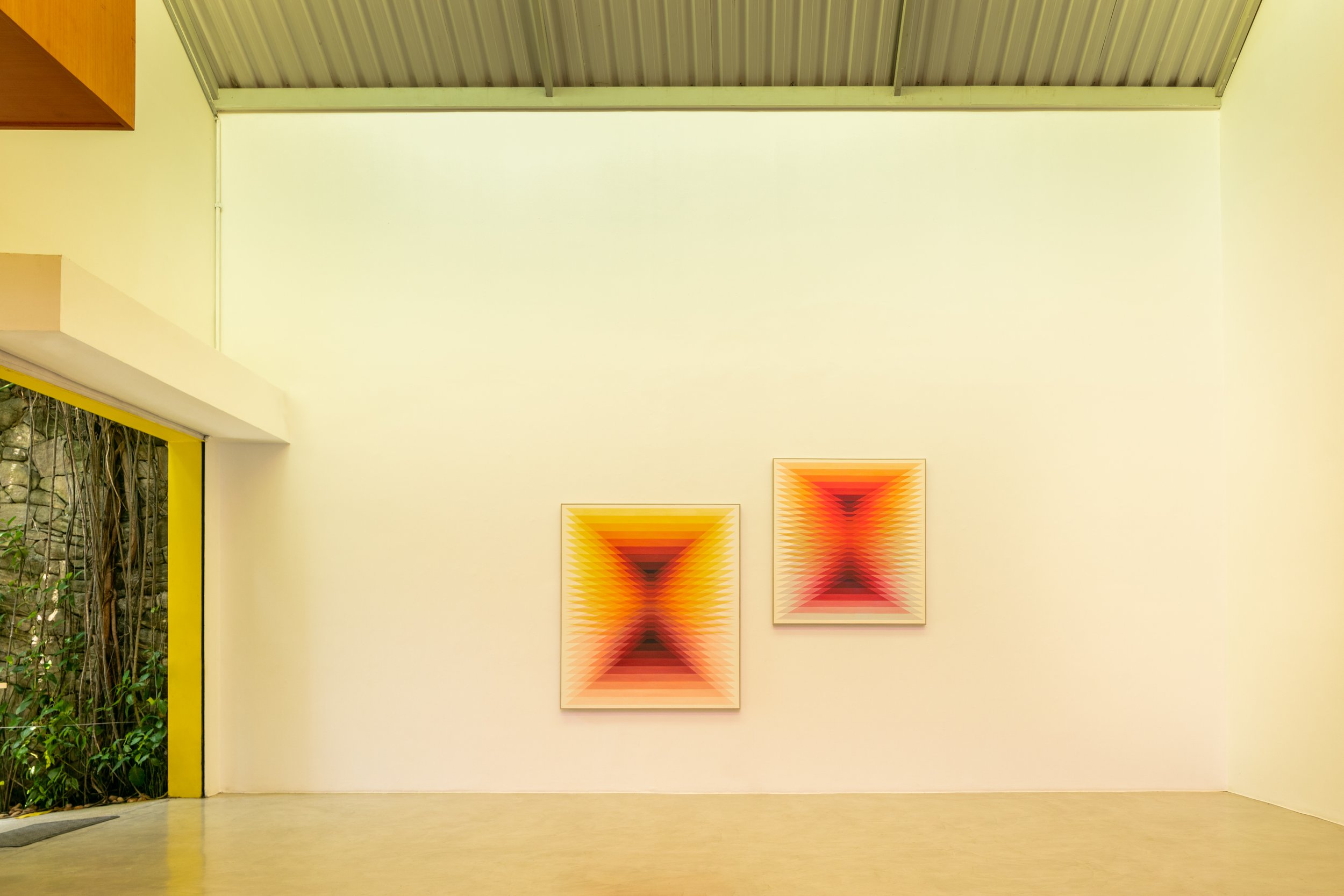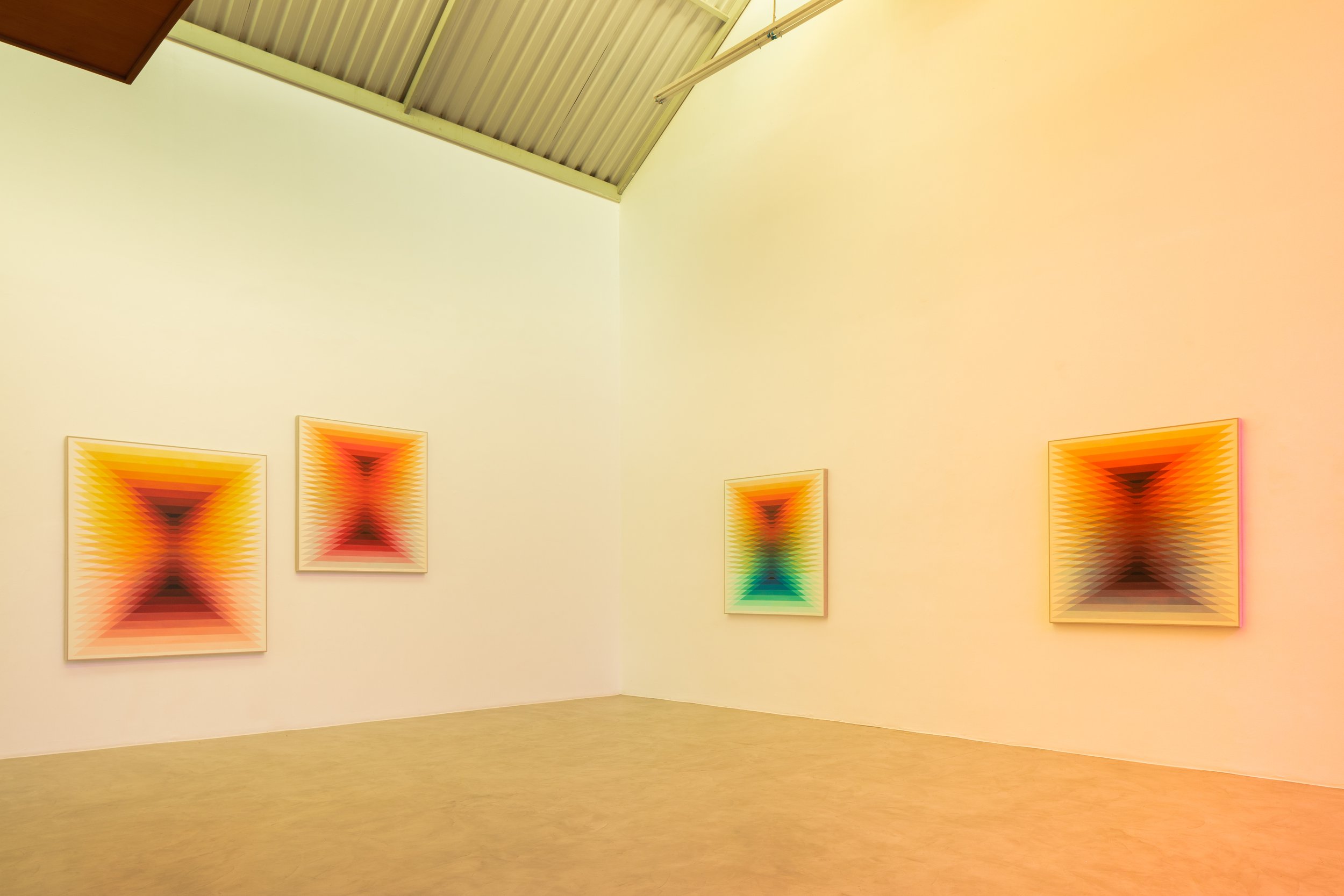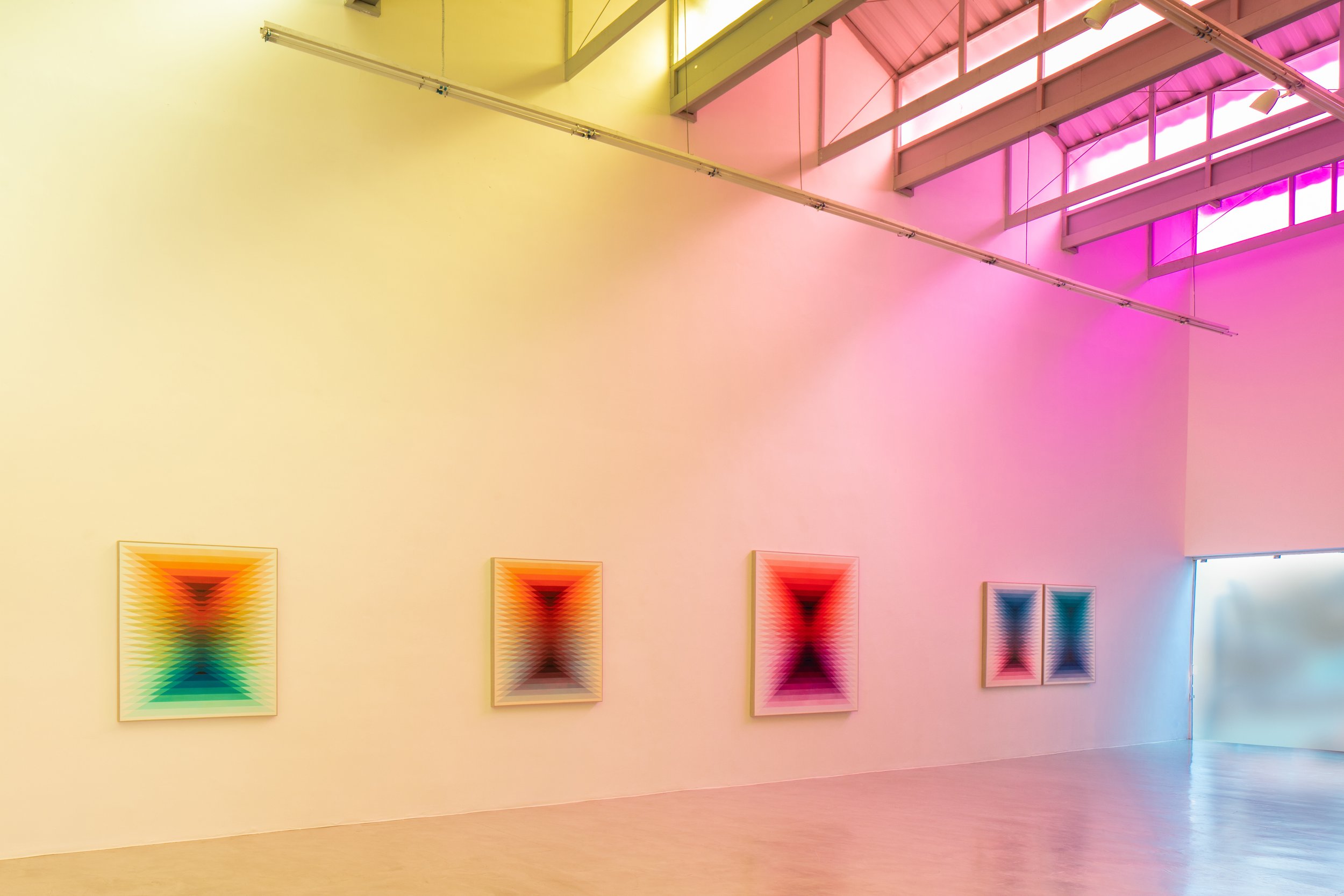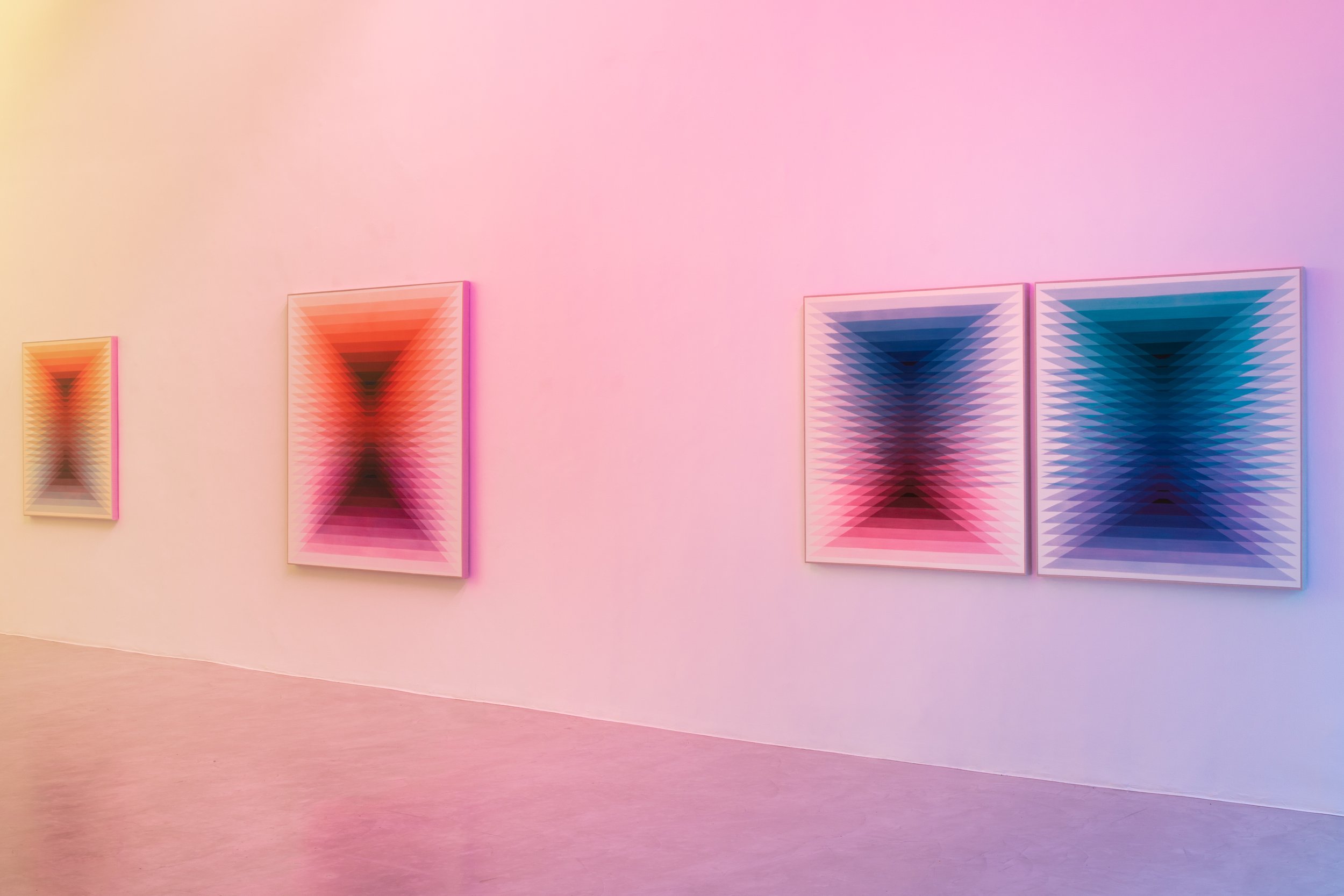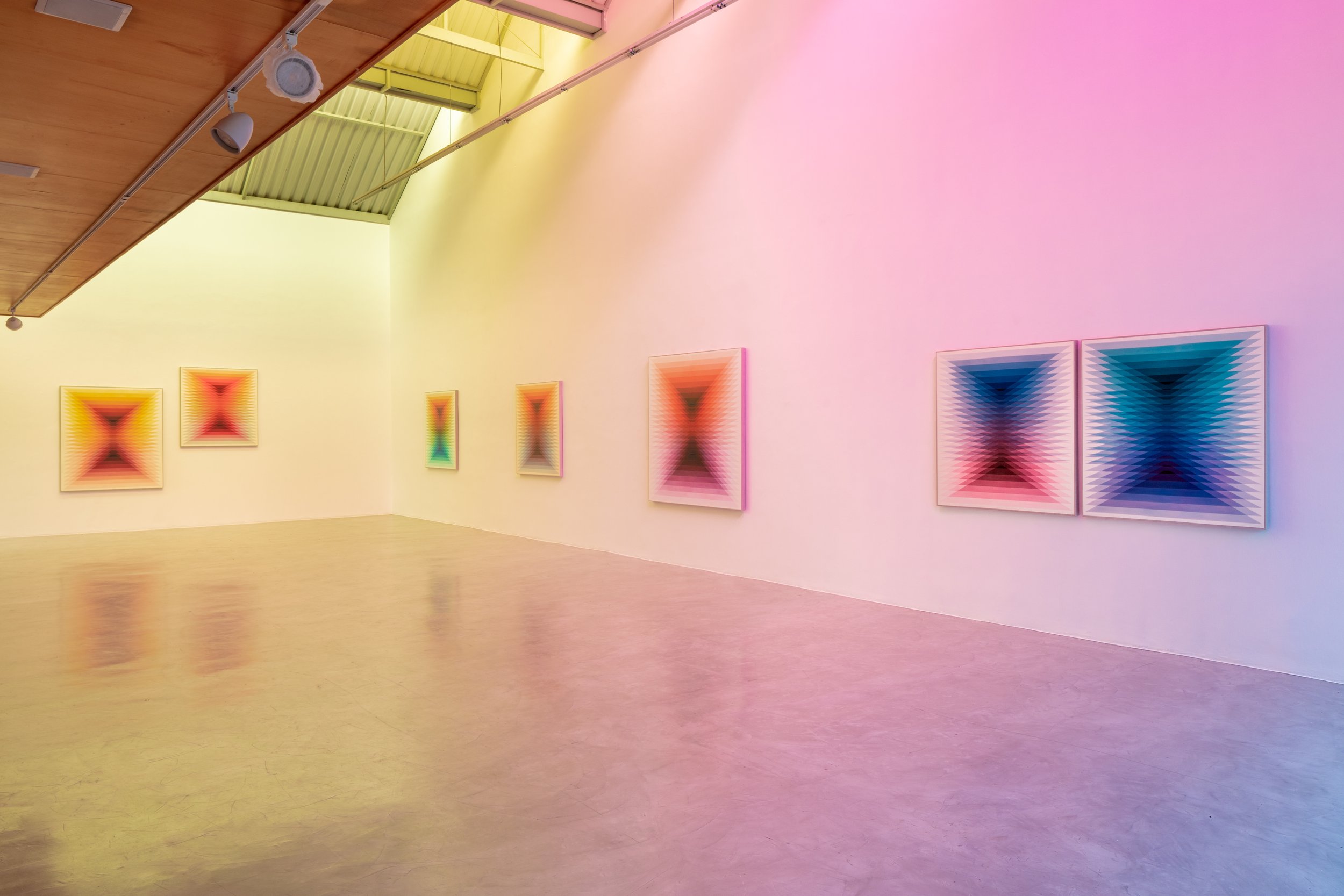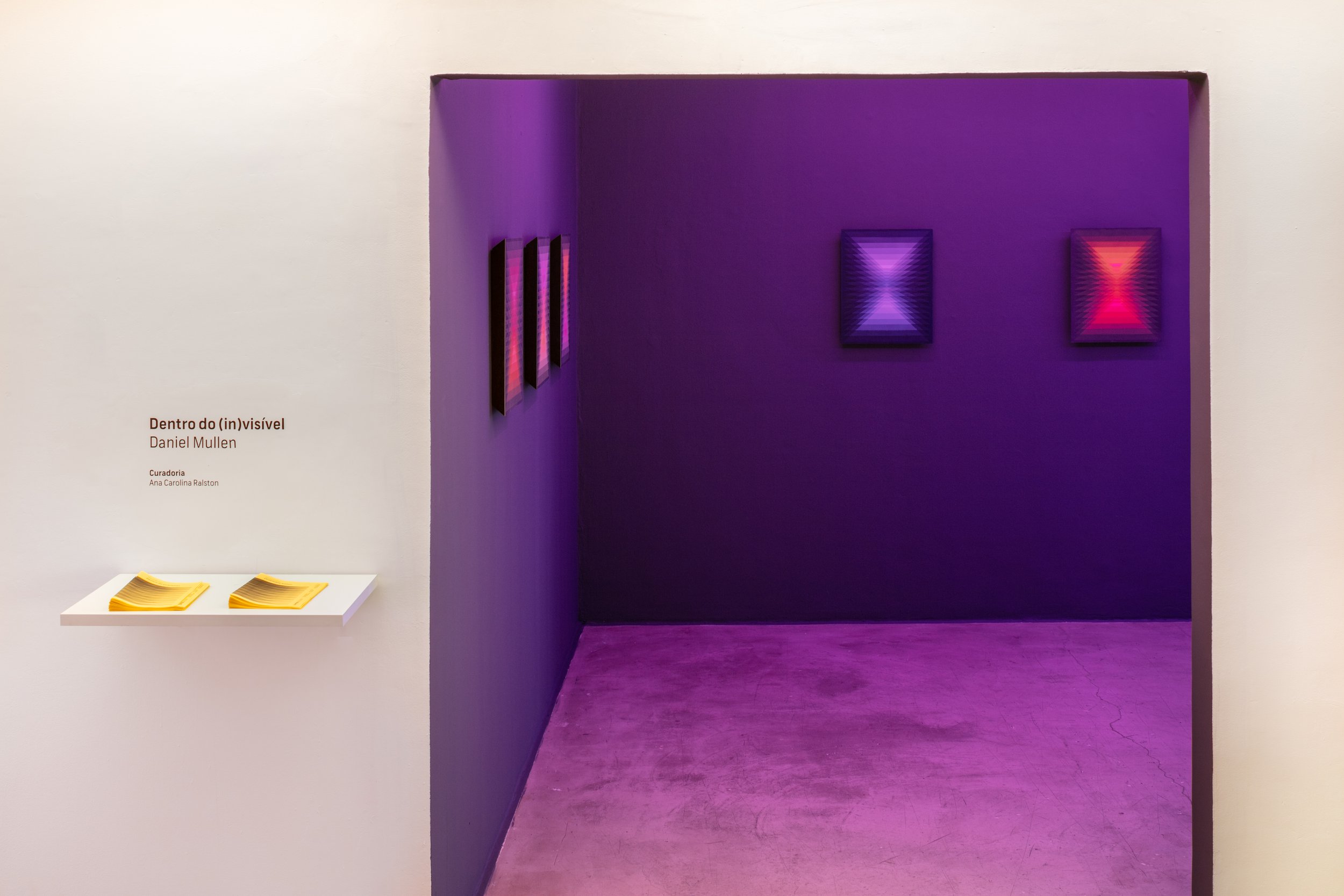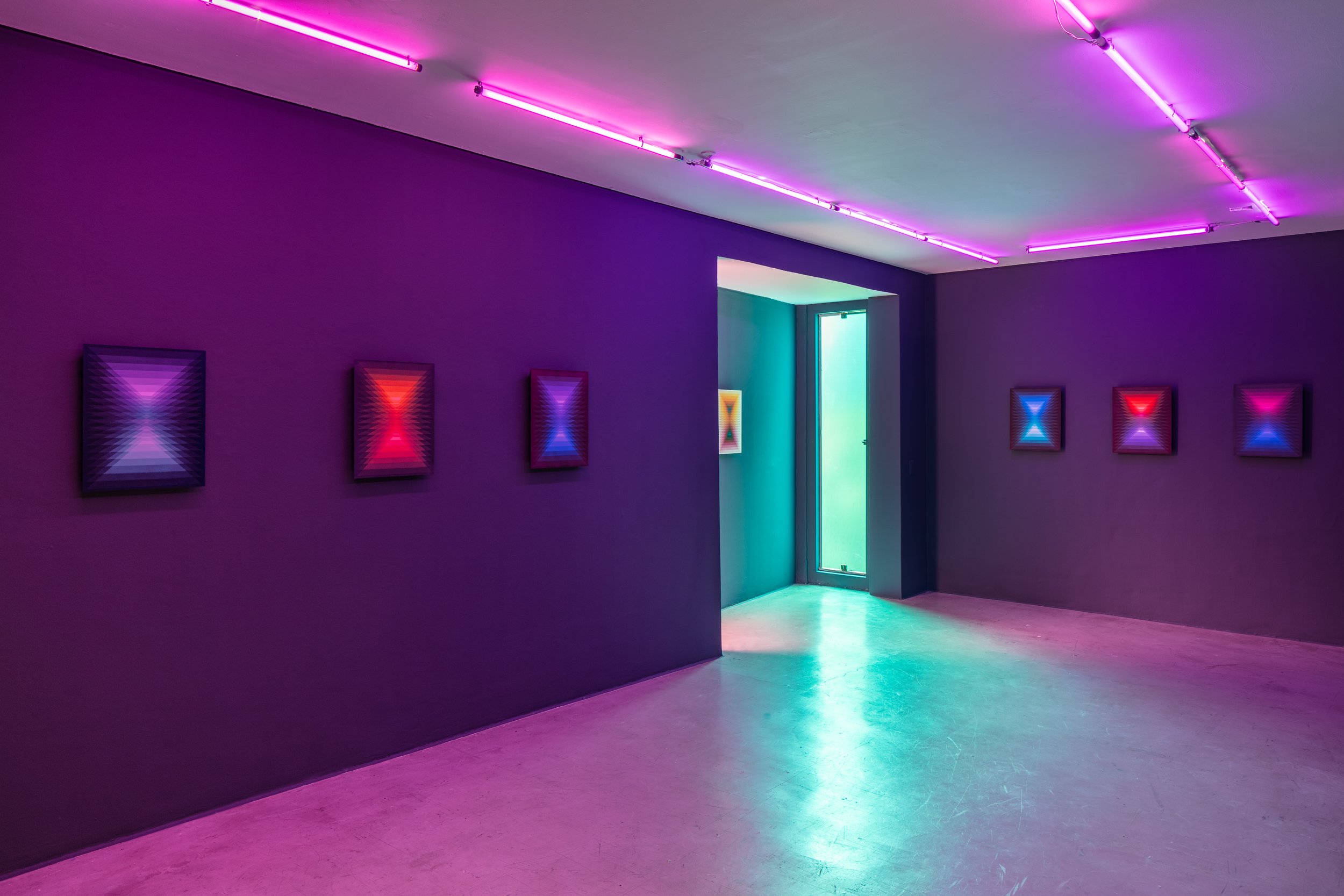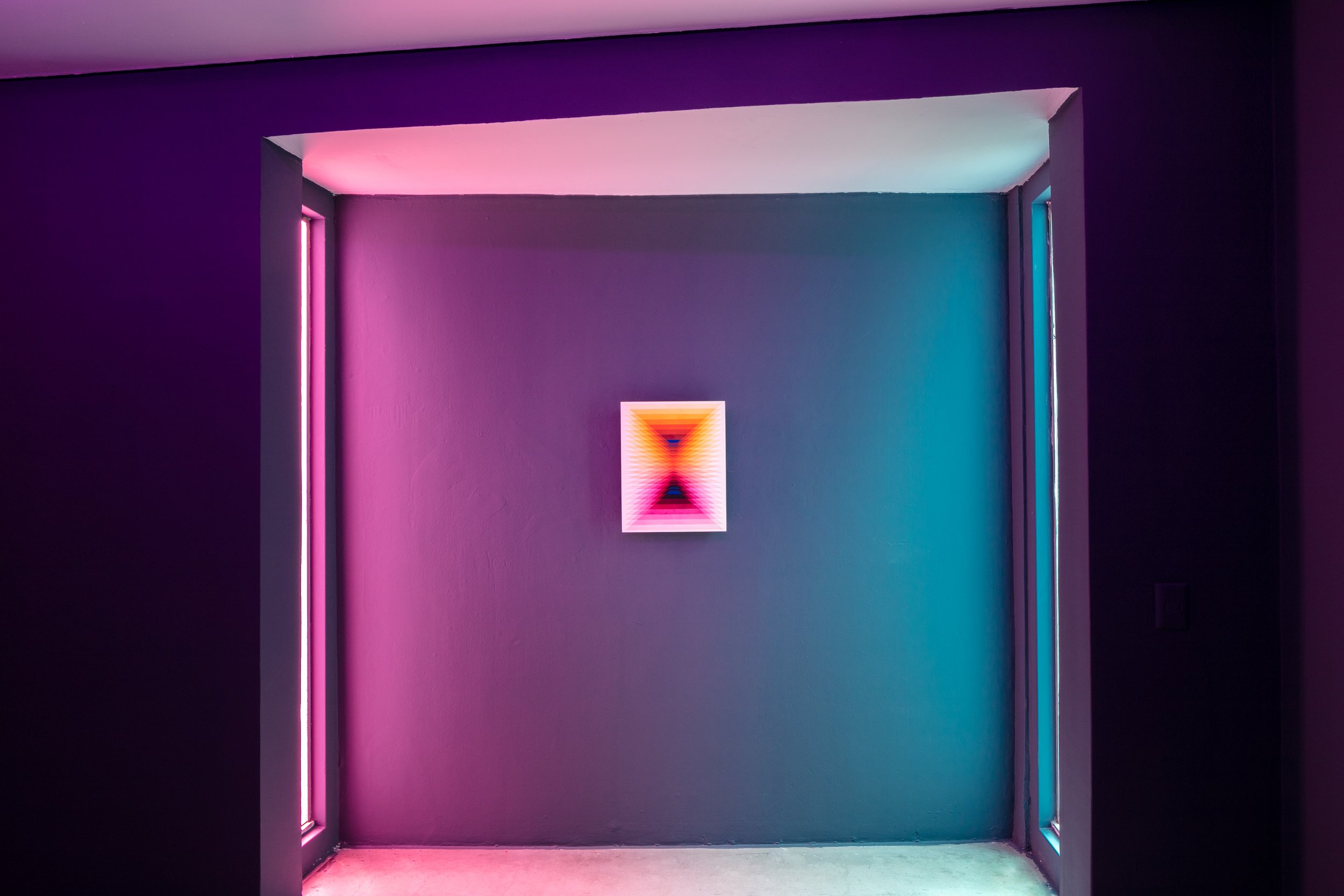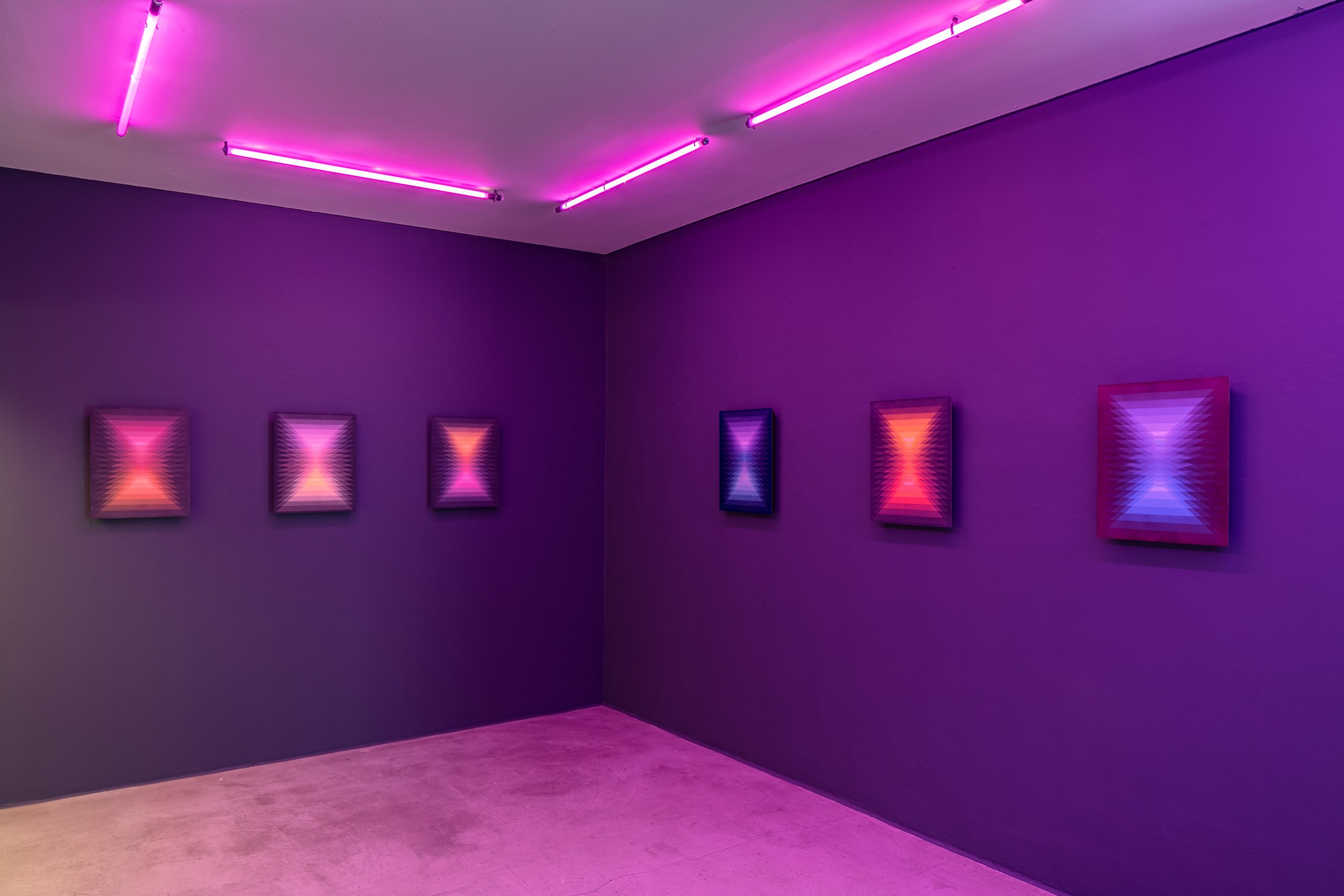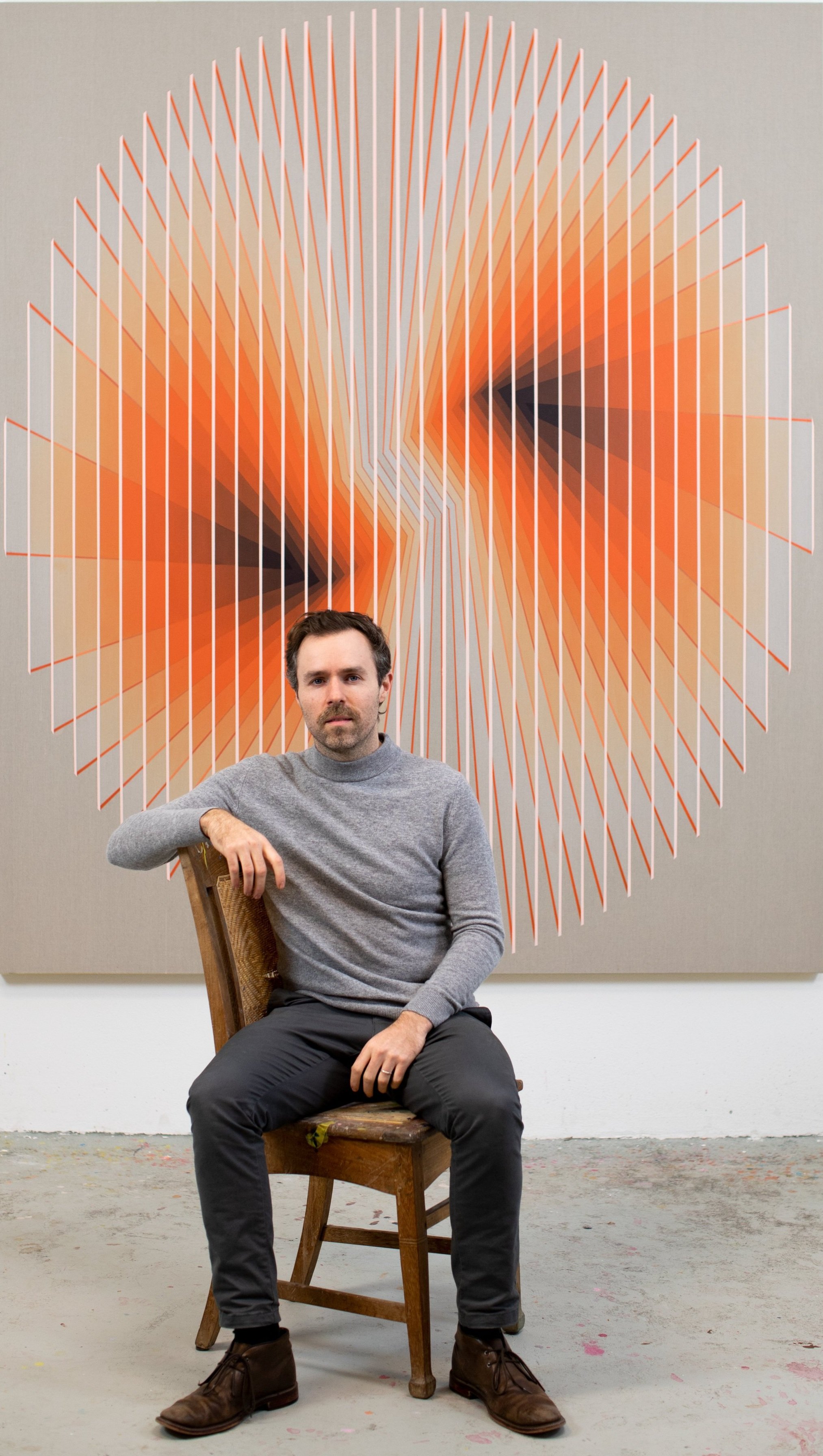ABOUT
Rotterdam-based painter, Daniel Mullen, was born in Glasgow, Scotland 1985.
The question of sense perception is not limited to how we might perceive light, darkness, form, and color. We subsist in a precarious environment, in an era of mass digitization. How might our visual and emotional sensitivities be shifting as we find ourselves flowing between our physical environment and the techno-sphere, aided in part by back-lit digital devices?
With his work, Mullen aim’s to question these shifting modes of perception through dialectical compositions, and expressions of color light, and darkness. That results in works that might appear as digital renderings however upon closer inspection reveal the materiality by which they are constructed. A time-consuming craftsmanship that does not seek binary perfection, but rather embraces nuisance, imperfection, and materiality.
(In)Visible Within
Zipper Galeria, Sao Paulo-2022
Text and Curation by Ana Carolina Ralston
“One line plus one line results in many meanings.” Josef Albers
In the beginning, there was nothing. In Western culture, darkness is usually associated with judgment and the moral idea of sin, death, and loneliness. Meanwhile, for the worldview of many aboriginal peoples in Latin America, darkness is related to the opposite universe, directly connected to creation, birth, and rebirth. Death is not the end, nor is it feared, but rather worshiped by different civilizations, from the pre-Columbian to the Guarani, who have occupied Brazil’s Atlantic Forest for centuries. Light is made through these consecrations. In experimenting with such contrasts, volumes emerge that provide us with an interesting game of concealing and revealing. The exhibition (In)Visible within, Daniel Mullen’s first solo show at Galeria Zipper, is about luminosity and its delicate and decisive relations with its surroundings.
The refraction of light that establishes itself is discussed in a complementary manner within both environments that make up the artist’s exhibition at the space located in Jardim América, in São Paulo. After all, the eye owes its main function to such a phenomenon. As Johann Wolfgang von Goethe (1749-1832) describes in his provocative The Theory of Colours, “Light produces an organ that becomes its equal. Thus, the eye is formed in the light and for the light, so that the inner light meets the outer light.” If on the one hand there is the clarity that bathes the first floor and the fifteen paintings displayed in this room, on the other hand, there is the darkness used as a backdrop for the works on paper under beveled wood and displayed on the second floor, where they seem to float in a more somber and intimate environment, which allows us to witness a new vein of the painter’s practice.
It is important to point out, however, that the progressive and rhythmic awakening of the luminosity present in Mullen’s production places us before another pillar of the artist’s practice, colour. In a symbiotic relationship, different nuances produce a fluctuating and organic dance embodied on canvas and/or paper. These works provide us with the experience of materiality and spatiality of light and colour proposed by the artist. As in a duel, the chromatic layers seem to advance, move away, and become transparent; the medium is transformed into a field of forces that gradually overlap, creating intersections between the two opposing planes exhibited. And the longer the viewing time, the greater the amplitude of these effects.
At first glance, Mullen’s production reveals itself to us as something mechanical, precise, schematic, and purely rational; as the appropriate realization of a project. “Disappointingly simple and yet immensely sophisticated,” as the Swiss-American historian François Bucher (1927-1999) described the work of Josef Albers (1888-1976). The resourcefulness with which Albers’ chromatic investigation develops is very similar to that of Mullen. Both creators allow us to open a new channel through their investigations and their infinite combinations transmuted into sensations, resulting in a precise study that involves the phenomenological aspect of colour and space.
Scottish Artist Daniel Mullen Uses a Meditative Process to Create Paintings as Dazzling as They Are Exacting
"Future Monuments," the artist's current series, tries to translate the intangible experiences of sound, light, and space.
Scottish artist Daniel Mullen creates optically dazzling works using a process that includes the application of thin, translucent layers of paint on exposed linen. For Mullen, his technique is central to his concept. Incredibly precise and angular, these hard-edged geometric works are achieved through an exacting and time-consuming process of measuring and taping his canvases. The artist, who has described himself as an impatient person, uses painting as a meditative process of repetitive movement and rhythm, with the brush working as an extension of his person. Mullen shows with Elan Fine Art in Vancouver, B.C., and is currently working on “Future Monuments,” a series that attempts to assign visual corollaries to the amorphous experiences of sound, movement, light, and shadow.
Mullen’s meticulous visions often depict panes of glass arranged in precise forms. Other times, the images are more of a whirlwind, looking as though the planar forms of an architectural blueprint were swirled about in a gust of wind. All the works embrace an exactitude of line and angle, appearing impeccable from a distance. Up close, however, small vacillations and shifts in brushstrokes reveal evidence of the artist’s hand. Such details gesture to the link between the artist’s body and its output in a refreshingly intimate way. Rather than belonging to an austere, hard-edged aesthetic, Mullen sees his works as rooted in a spiritualized abstraction and the visual idioms of Hilma af Klint, Josef Albers, Bridget Riley, and Swiss artist Emma Kunz, in particular.
“The visual language originates from my formative education at a Rudolf Steiner school, where I learned the technique of veil painting, which uses heavily diluted paint applied in rhythmical overlapping layers. In Steiner’s pedagogy, it is believed that this way of painting creates an atmosphere in which color fields can permeate beyond the support surface. I utilize this technique as a way to create an ethereal effect…I would visually place my work somewhere between geometric abstraction and the Light and Space movement of California. I’m interested in phenomenology—to sense something that is not present, or at least that which seems undefinable, a space out of reach beyond our perception,” wrote Mullen.
Extract from an article by Artnet
An extract From the solo exhibition ‘Ephemeral Fields’ at Galeria Kogan Amaro / Zürich by Cynthia Garcia, an art historian and critic:
“Field connotes a body or a realm, and ephemeral means a fleeting, transitory or a brief moment in time”, explains abstract painter Daniel Mullen, known for his play with geometrical optical illusion, spatial perspective and light, to refer to the multiple horizons in his present paintings. The body of work for the solo exhibition “Ephemeral Fields” by artist Glasgow-born Daniel Mullen at Kogan Amaro / Zürich stems from the question “in what way might we imagine a future monument or the idea of a monument”. For the artist, the monument of the future does not uphold existing structures. It is neither dominating, oppressive, predetermined nor physically definable. Instead, it is light, space and movement expanding our perception in order to open our imagination to other futures. In the series the eye tracks across an image or “between images”, registering different aspects of the pictorial fields. It is what he means by an ephemeral experience. “I wish to offer a transitory experience that is not necessarily definable, a birthing if you will”, explains the artist on the works painted over transparently primed linen that seeps through the translucent layering of paint into the illusionistic weightlessness of the abstracted forms.
A prominent part in Mullen’s work is his expert use of colour aiming to affect the perception of the viewer. For him, colour and laying the layers down is an almost alchemic sensorial experience. In the paintings, the complex organization and meticulous execution of form and structure come into play to guide the viewer through relationships that are offered through illuminated hues and fleeting perspectives of aerial compositions. Are they thresholds? Portals? Space and weightless architecture remain present in the imaginative universe of the artist.
In his early works, Mullen had as references Neo-plasticism and “De Stijl”, with artists such as Mondrian and Theo Van Doesburg, most notably El Lissitzky and the Constructivism movement. In ”Ephemeral Fields” the pivotal inspirations are Hilma af Klint, Josef Albers and Bridget Riley along with the visual language of Swiss Emma Kunz, among others. “Now when thinking about movements, I would visually place my work somewhere between Geometric Abstraction and the Space and Light movement of California”, he acknowledges. “In my work, I’m interested in phenomenology; to perceive something that is not present or at least that which seems undefinable, a space out of reach beyond our perception. Through the act of painting, I try to channel this experience for another viewer beyond my own mind’s eye by seeking to render colour, form and light perceivable”.
The solo exhibition “Ephemeral Fields” by Daniel Mullen is his first at Kogan Amaro / Zürich. In 2019, the artist exhibited the solo “Colour Equation” at Kogan Amaro / São Paulo. The Swiss exhibition comprises of 23 paintings with an average size of 150 x140 cm, the largest being a 400 x 190 cm diptych.
His career started from the natural passion architecture and spaces exert on him. The artist creates perspectives, toying with optical illusions, which come to place by combining pigmentation and geometry.”
In conversation with Bob van Orsouw about the work presented in “Ephemeral Fields”, a solo show at Galeria Kogan Amaro Zurich.
In conversation with Bob van Orsouw about the work presented in “Ephemeral Fields”, a solo show at Galeria Kogan Amaro Zurich.

